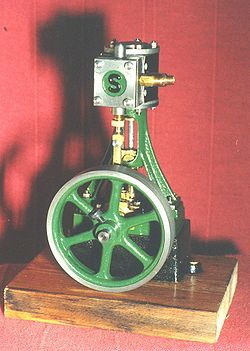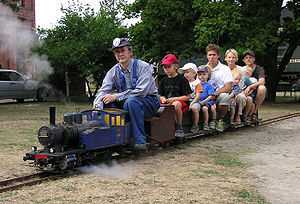
Model engineering
Encyclopedia

Hobby
A hobby is a regular activity or interest that is undertaken for pleasure, typically done during one's leisure time.- Etymology :A hobby horse is a wooden or wickerwork toy made to be ridden just like a real horse...
of constructing machines in miniature. The term was in use by 1888. There is some debate about the appropriateness of the term. Some say that all 'engineers' should be professionally qualified as such; however, the historic meaning of 'engineer' is one who constructs or tends engines, and as such is a fitting epithet for those who make working models as a hobby. In the United States
United States
The United States of America is a federal constitutional republic comprising fifty states and a federal district...
, the term home shop machinist is often used.
The 'classic' areas of interest are live steam
Live steam
Live steam is steam under pressure, obtained by heating water in a boiler. The steam is used to operate stationary or moving equipment.A live steam machine or device is one powered by steam, but the term is usually reserved for those that are replicas, scale models, toys, or otherwise used for...
models (typically steam locomotives, stationary engines and traction engine
Traction engine
A traction engine is a self-propelled steam engine used to move heavy loads on roads, plough ground or to provide power at a chosen location. The name derives from the Latin tractus, meaning 'drawn', since the prime function of any traction engine is to draw a load behind it...
s), internal combustion engines, and clock
Clock
A clock is an instrument used to indicate, keep, and co-ordinate time. The word clock is derived ultimately from the Celtic words clagan and clocca meaning "bell". A silent instrument missing such a mechanism has traditionally been known as a timepiece...
making. Other popular subjects are Stirling engines, workshop equipment, miniature machine tools and ornamental turning. These constitute stable genres which are often reflected in competition categories at model engineering exhibitions. In the past, amateur electrical experimentation (the precursor to hobby electronics) and ship modelling were considered as part of model engineering, but these are no longer regarded as core genres.
Model engineers typically produce models made in metal. These are machined from stock metal and castings. Some of these are intended as utilitarian working models, others as highly meticulous display models, or sometimes a combination of both. The model engineer usually purchases commercially available drawings which are used as reference to make the models. However some people produce their own drawings, or even work without drawings. The most elaborate models involve hand manufacture of thousands of parts, taking thousands of hours to complete, usually over a number of years or even decades. There are some complete pre-manufactured kits available, but these are limited in the choice of subject matter and are usually expensive.
Model engineering kits

Machined kits are a set of parts that are fully machined and only require finishing with hand tools, painting, etc. Workshop machinery is not required. The kit will typically contain all the parts necessary to complete the kit, including all fixings, pressure gauges and other steam fittings, etc. These kits require a lot less work than an unmachined kit, but are very expensive. Availability tends to be limited as productions runs are small due to the high price.
Building from scratch
Many builders do not use any pre-fabricated parts, ready-made castings, or even drawings. This is called "building from scratch", and it adds another facet to the hobby.Model engineers
Historically, some of the leading names in the hobby have been those who encourage others through their writings, notably Edgar T. WestburyEdgar T. Westbury
Edgar T. Westbury was perhaps best known as a major contributor to the English recreational magazine Model Engineer. He contributed under his own name, and also under the pseudonyms 'Artificer' and 'Kinemette'. Beginning in 1925 until his death in 1970, he made over 1474 authored contributions to...
, "LBSC
LBSC
* London, Brighton and South Coast Railway* LBSC, pen name of Curly Lawrence, model steam locomotive engineer...
" (Lillian "Curly" Lawrence), Martin Evans
Martin Evans (model engineer)
Martin Evans was a major contributor to the English recreational magazine Model Engineer. He was promoted from Technical Editor to Editor of the magazine in January 1966.. His editorship, along with a change in almost all other staff on the magazine, is credited as having saved it from decline....
and Tubal Cain (T. D. Walshaw)
Tom Walshaw a.k.a. Tubal Cain (model engineer)
Tom D. Walshaw was an engineer, author and contributor to the British magazine Model Engineer. Many of his magazine contributions and books were authored under the pseudonym Tubal Cain. The pseudonym relates to the eponymous biblical metal worker. As Tubal Cain he made over 424 contributions to...
, all writing for the British Model Engineer magazine
Model Engineer magazine
Model Engineer Magazine was first published to support the hobby of model engineering in 1898 by Percival Marshall, who was to remain its editor for over 50 years. It has been published by My Hobby Store since 2008. The magazine addressed the emergence of a new hobby — the construction of models ...
. Kozo Hiraoka has authored several series of logging locomotive articles in the U.S. magazine Live Steam
Live Steam magazine
Live Steam & Outdoor Railroading magazine is a magazine published in the United States that was founded in 1966...
.
Many of the projects published by these authors contain detailed instructions and drawings for building steam and petrol engines, as well as locomotives in scales ranging from 1:24 to 1:8, capable of carrying passengers on a backyard railroad
Backyard railroad
A backyard railroad is a privately owned, outdoor railroad, most often in miniature, but large enough for one or several persons to ride on. The rail gauge can be anything from to or more. Smaller backyard or outdoor railroads that cannot be ridden are called garden railroads.Hundreds, even...
track.
The quality of work of some modern proponents of the hobby is astonishing, foremost among living model engineers are Cherry Hill, Gerald Wingrove
Gerald Wingrove
Gerald A. Wingrove MBE is a model engineer and author from the United Kingdom.-Biography:Wingrove has produced extremely detailed miniature models of ships and cars for nearly four decades...
and Barry Jordan.
Tools
Tools used for model engineering include the latheLathe (metal)
A metal lathe or metalworking lathe is a large class of lathes designed for precisely machining relatively hard materials. They were originally designed to machine metals; however, with the advent of plastics and other materials, and with their inherent versatility, they are used in a wide range of...
, the mill
Milling machine
A milling machine is a machine tool used to machine solid materials. Milling machines are often classed in two basic forms, horizontal and vertical, which refers to the orientation of the main spindle. Both types range in size from small, bench-mounted devices to room-sized machines...
, the shaper
Shaper
A shaper is a type of machine tool that uses linear relative motion between the workpiece and a single-point cutting tool to machine a linear toolpath. Its cut is analogous to that of a lathe, except that it is linear instead of helical...
, and the drill press. Until the introduction of cheap mini-lathes by suppliers such as Warco, Harbor Freight, Grizzly and others, lathes produced by Myford
Myford
Myford Limited was a British machine tool manufacturer based in Beeston, Nottinghamshire in the United Kingdom and notable for its production of metalworking lathes....
or Bridgeport were fairly ubiquitous in model engineering.
See also
- Bassett-LowkeBassett-LowkeBassett-Lowke was a toy company in Northampton, England, founded by Wenman Joseph Bassett-Lowke in 1898 or 1899, that specialized in model railways, boats and ships, and construction sets...
- MachiningMachiningConventional machining is a form of subtractive manufacturing, in which a collection of material-working processes utilizing power-driven machine tools, such as saws, lathes, milling machines, and drill presses, are used with a sharp cutting tool to physical remove material to achieve a desired...
- MetalworkingMetalworkingMetalworking is the process of working with metals to create individual parts, assemblies, or large scale structures. The term covers a wide range of work from large ships and bridges to precise engine parts and delicate jewelry. It therefore includes a correspondingly wide range of skills,...
- Steam EngineSteam engineA steam engine is a heat engine that performs mechanical work using steam as its working fluid.Steam engines are external combustion engines, where the working fluid is separate from the combustion products. Non-combustion heat sources such as solar power, nuclear power or geothermal energy may be...
- Model engineModel engineIn radio-controlled modeling, a model engine is an internal combustion engine used to power a radio-controlled aircraft, radio-controlled car, radio-controlled boat, free flight and control line aircraft, and tether car models also use these engines....
- Model steam engineModel steam engineA model steam engine is a small steam engine built as an educational toy for children or for adult live steam enthusiasts...
- Carbureted compression ignition model enginesCarbureted compression ignition model enginesSimple compression ignition engines are made for model propulsion, usually model aircraft but also model boats. These are quite similar to the typical glow-plug engine that runs on a mixture of methanol-based fuels with a hot wire filament to provide ignition...
- Glow Engines

